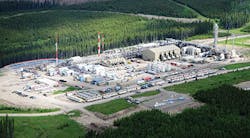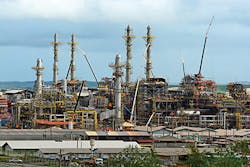Oil and Gas Journal's semiannual Worldwide Construction Update shows an increase in petrochemical construction activity compared with the previous edition of the update (OGJ, Nov. 3, 2014, p. 34). Following are details from the latest survey, which is available on OGJ Online (see box).
Refining
In March, Petroleo Brasileiro SA commissioned the first of two 75,000-b/d delayed coking units at its Abreu e Lima refinery (Rnest) at the port of Suape, near Recife. Start-up of the delayed coker, which took place on Mar. 13, completed commissioning of all processing equipment to be included in Rnest's first 115,000-b/d phase. The company also began start-up activities on a diesel hydrotreater as part of the commissioning process for the refinery's second 115,000-b/d production train, which is due to come on line later this year (OGJ Online, Mar. 13, 2015).
Mangalore Refinery & Petrochemicals Ltd. (MRPL) completed its modernization project designed to increase the capacity and flexibility of crude oil processing at the plant (OGJ Online, June 8, 2010). MRPL wrapped the long-delayed Phase 3 expansion and upgrading project in late 2014 after it completed start-up of the third train of a three-train sulfur recovery unit, a raw water treatment system, LPG mounded bullet storage tanks, and other related offsite facilities (OGJ Online, Nov. 13, 2014). The Phase 3 expansion, which boosted the refinery's crude processing capacity to 15 million tonnes/year (tpy), also included the following units:
• A 2.2 million-tpy fluidized catalytic cracking unit (OGJ Online, Aug. 27, 2014).
• A 650,000-tpy coker heavy gas oil hydrotreating unit (OGJ Online, May 15, 2014).
• A 3 million-tpy delayed coking unit (OGJ Online, Apr. 4, 2014).
Meanwhile, Petroleos Mexicanos let a $1.3-billion contract to Fluor Corp. unit ICA Fluor's industrial engineering-construction joint venture with Empresas ICA SAB de CV to build a delayed coker at the Miguel Hidalgo Refinery in Tula, Hidalgo, Mexico (OGJ Online, Dec. 4, 2014). ICA Flour will provide detailed engineering, procurement, and construction services for the coker, which will have a processing capacity of 86,000 b/d. Mechanical completion of the project is scheduled for second-quarter 2018.
Petrochemical
In February, Williams Partners LP commissioned and started production of ethylene from its newly rebuilt and expanded Geismar, La., olefins plant following a series of setbacks occurring in the wake of a June 2013 explosion at the site (OGJ Online, June 13, 2013). Prior to the 600 million-lb/year expansion project, the Geismar plant had an ethylene production capacity of 1.35 billion lb/year.
Shell Chemicals Ltd. completed upgrades to improve efficiency and boost production volumes at its Shell Deutschland Oil GMBH-operated petrochemicals plant at Wesseling, Germany. The revamp involved modifications to furnaces, compressors, column systems, tubes, and pipes at the complex's 2A naphtha steam cracker. The project also has enabled the upgraded 2A steam cracker to increase production of ethylene, propylene, C4, and pygas by 15%.
ZapSibNeftekhim LLC started construction on its long-planned integrated ethylene, polyethylene, and polypropylene production complex at Tobolsk in western Siberia's Tyumen region (OGJ Online, Feb. 20, 2015). The ZapSibNeftekhim (ZapSib-2) complex will include a 1.5 million-tonne/year ethylene steam cracker, four polyethylene production units with a production capacity of 1.5 million tpy, a 500,000-tpy polypropylene production unit, and a 100,000-tpy butane-butylene fractionation unit. As of late 2014, ZapSib-2 was scheduled to be commissioned in 2019-20.
A joint venture of Yara International ASA and BASF Group agreed to build a world-scale ammonia plant in Freeport, Tex., that will require expansion of hydrogen-production capacity by supplier Praxair Inc. (OGJ Online, Feb. 20, 2015). The 750,000-tpy ammonia plant will be built at BASF's complex in Freeport for a total capital investment estimated at $600 million. Yara, owning 68% of the plant, will build an ammonia tank at the BASF terminal, increasing its total investment to $490 million. BASF, with the remaining 32%, will upgrade its terminal and pipelines. The plant will use the ammonia synthesis process of KBR Inc., which has the engineering, procurement, and construction contract. Praxair produces hydrogen via steam reforming of methane and can augment supply with byproduct hydrogen captured at crackers. It expects its pipeline expansions to be in operation in 2016 and deliveries to the ammonia plant to begin late in 2017.
Arabian Petrochemical Co. (Petrokemya), a wholly owned subsidiary of Saudi Basic Industries Corp., let a contract to KBR Inc. for work related to the expansion of a butadiene plant at its 5.15 million-tpy petrochemical complex in Al Jubail, Saudi Arabia (OGJ Online, Nov. 6, 2014). KBR will provide front-end engineering design for the debottlenecking and expansion of the butadiene extraction plant.
LNG, natural gas
The Environmental Protection Authority of Western Australia has approved plans for expansion of the Gorgon-Jansz LNG project on Barrow Island into a fourth train (OGJ Online, Mar. 4, 2015). The expansion will see the Chevron Corp.-led group push the foundation production of 15 million tpy of LNG up to a total of 20 million tpy. The expansion project includes construction of a feed gas pipeline system along either the Northern Pipeline Route Option or the Southern Pipeline Route Option plus the addition of a fourth LNG train on Barrow along with associated systems within the existing plant.
Williams Partners LP and Crestwood Midstream Partners LP commissioned the Bucking Horse gas processing facility in Converse County, Wyo., adding 120 MMcfd of processing capacity in the Powder River basin's Niobrara shale play. The Bucking Horse plant, along with the Jackalope Gas Gathering System, is owned through a 50-50 joint venture of Williams Partners and Crestwood Midstream Partners.
Targa Resources Partners LP will buy and install a 300-MMcfd cryogenic gas processing plant, a header pipeline originating at the plant into the southern portion of the Delaware basin, and related gathering and compression (OGJ Online, Oct. 8, 2014). The plant will be in Winkler County, Tex., west of Targa's existing Sand Hills gas processing plant to provide additional services to producers on the western side of the Permian basin. The processing plant is to be operational at the end of first-quarter 2016. Targa also approved the purchase of a 200-MMcfd cryogenic plant to be built in McKenzie County, ND, in the Williston basin. The additional Badlands plant is to be operating as early as yearend 2015.
OMV Tunisie Production GMBH let a $216-million contract to ABB for a gas plant associated with development of Nawara gas field in southern Tunisia (OGJ Online, May 30, 2014). With design capacity of 2.7 million standard cu m/day, the plant is to start production by October 2016. The turnkey contract covers delivery of the plant, including gas separation and LPG extraction units. It also covers automation, communications, and power components. ABB will work with Thermo Design Engineering Ltd., Edmonton, on execution of the contract, total value of which is $291 million. The OMV unit is developing Nawara field in a 50-50 venture with ETAP, the state-owned oil company.
Other gas, sulfur
Sasol Ltd. will delay the final investment decision on a large-scale, gas-to-liquids plant in Louisiana as part of the company's plan to conserve cash in response to lower international oil prices (OGJ Online, Jan. 28, 2015). The timing of the decision will take into consideration progress made with the execution of Sasol's ethane cracker and derivatives complex in Westlake, La., prevailing market conditions, and other strategic investment opportunities.
The company in late 2013 chose Technip as the primary contractor for the front-end engineering and design phase of the facility (OGJ Online, Nov. 25, 2013). Sasol is proceeding with construction of its ethane cracker and derivatives complex, for which a $4-billion credit facility was secured in December (OGJ Online, Dec. 23, 2014). The company says it's confident that, given "robust project economics," the facility is the first step in developing the site near Lake Charles into an integrated hub. The company also will continue to advance its investments in various gas and chemicals projects in southern Africa, it says.
In Carabobo, Foster Wheeler is working on a 250-tonne/day sulfur unit for Petroleos de Venezuela SA. The project will be completed in 2016.
Pipelines
Magellan Midstream Partners and Plains All American Pipeline LP reported that a wholly owned subsidiary of Anadarko Petroleum Corp. has exercised its option to purchase a 20% equity interest in Saddlehorn Pipeline Co. (OGJ Online, Mar. 19, 2015). As a result of the announcement, Saddlehorn's equity ownership would be Magellan 40%, PAA 40%, and Anadarko 20%.
Saddlehorn will construct, own, and operate the 20-in., 550-mile Saddlehorn pipeline system, which will transport as much as 400,000 b/d of various grades of crude oil from the D-J basin-and potentially the broader Rocky Mountain area resource plays-to storage facilities in Cushing, Okla., owned by Magellan and APP (OGJ Online, Feb. 27, 2015). The initial capacity of the Saddlehorn system is expected to be closer to 200,000 b/d.
The project is currently estimated to cost $800-850 million. Magellan will serve as construction manager and pipeline operator of the system, which subject to receipt of necessary permits and regulatory approvals, is expected to be operational by mid-2016.
Knight Warrior LLC has reached agreements to build its 160-mile, 100,000-b/d pipeline linking the East Texas Eaglebine-Woodbine crude oil play to Houston refining and export markets. Knight Warrior awarded Hatch Mott MacDonald LLC the project's engineering and design contract (OGJ Online, Jan. 27, 2015).
The 16-in. OD Knight Warrior East Texas project will start in Madison County, Tex., continuing south through Walker, Grimes, Montgomery, and Harris counties. Initial loading stations will be near North Zulch, Tex., and Madisonville, Tex., with a third planned near Roans Prairie, Tex., to accommodate anticipated production growth. The pipeline will be expandable to 200,000 b/d and be able to segregate and batch its crude shipments. The company expects the pipeline to begin operations second-quarter 2016. Shipper commitments, including Vitol and SEI Energy LLC, support the project. Knight Warrior East Texas will cost roughly $300 million. Knight Warrior LLC is owned by Blueknight Energy Partners LP, a joint venture of Vitol, which also owns 50% of its general partner, and SEI. It was initially targeting March 2016 completion (OGJ Online, Aug. 8, 2014).
Enterprise Products Partners LP will expand its Panola Pipeline Co. LLC NGL pipeline system, having received sufficient shipper interest to do so (OGJ Online, Jan. 22, 2015). The 181-mile system extends from Carthage, Tex., to Mont Belvieu, Tex., where it delivers to multiple destinations, including EPP's Mt. Belvieu fractionation complex. EPP plans to install 60 miles of pipeline as part of the expansion, as well as pumps and other related equipment designed to increase capacity by 50,000 b/d. The company expects the incremental capacity, serving Haynesville and Cotton Valley producers, to be available first-quarter 2016.
EPP also is building its 270-mile Aegis Pipeline header system to deliver ethane to US Gulf Coast petrochemical producers. It expects the line to begin operations second-quarter 2016.




